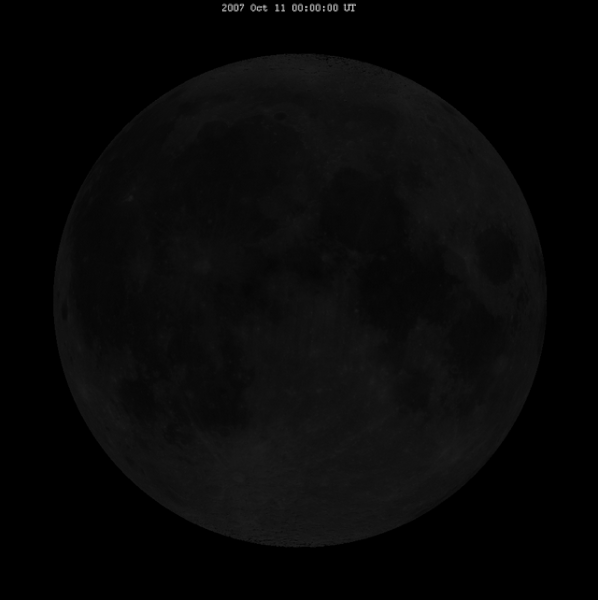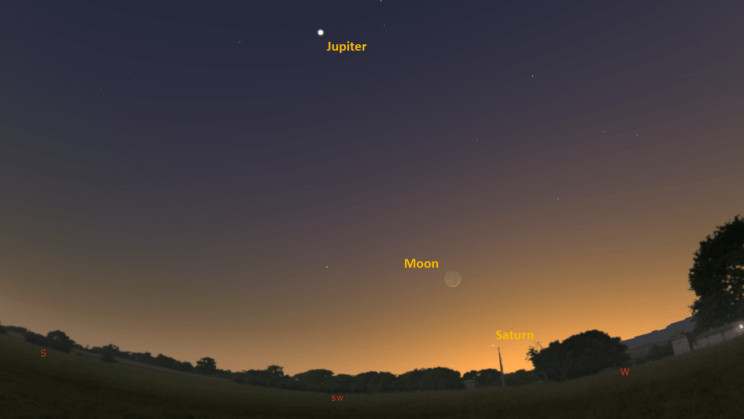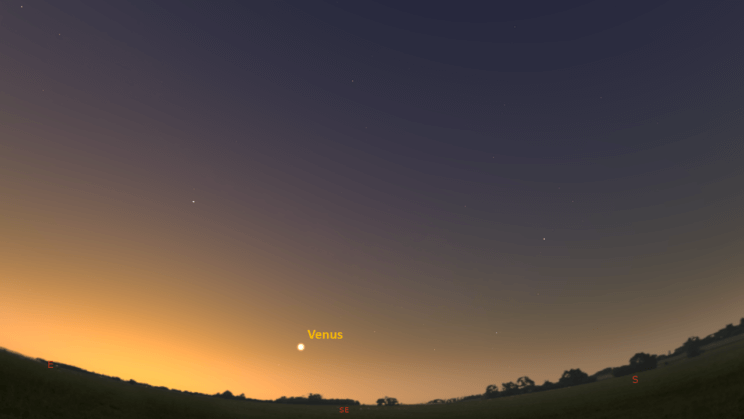This is the Saint Louis Science Center’s NIGHT SKY UPDATE for the week of Saturday, February 10, 2024.
Information updated weekly or as needed.
Times given as local St. Louis time which is Central Standard Time (CST). For definitions of terminology used in the night sky update, click the highlighted text. If relying on times posted in Universal Time (UT), St. louis is -6 hours when CST.
Join us for our next star party, Friday, March 1, 2024, held in association with the St. Louis Astronomical Society. For details, see the information at the bottom of this page or visit https://www.slsc.org/explore/mcdonnell-planetarium/public-telescope-viewings/
Observing Highlight of the Week

The image above is displaying a full cycle of moon phases. The wobble of the Moon in this image is called lunar libration which will impact what we see along the limb of the Moon. Image credit: Tomruen
This week we see the start of a new lunar phase cycle with new moon occurring on February 9, 2024. Over the next week we will see the Moon in the west after sunset as it progresses through its waxing crescent phases. I recently had a conversation with someone that reminded me this familiar behavior may not be familiar to everyone. With this in mind, I decided this week would be a good opportunity to revisit lunar phases exploring why it happens and what we have learned from this routine behavior.
Each month, the Moon will cycle through its phases starting with new moon. The first half of the cycle is called waxing which sees the Moon go from waxing crescent to first quarter to waxing gibbous and finally full moon. In this half of the phase cycle, we progressively see more of the Earth facing side reflecting sunlight.
The second half of the cycle is waning in which the Moon progresses through waning gibbous to last quarter to waning crescent and finally it returns to new moon starting the cycle over. In the second half of the phase cycle, each day we see less of the Earth facing side reflecting sunlight. This cycle takes roughly 29.5 days to occur, which is called a synodic month. The synodic cycle was once the basis for our calendars. While it is no longer a match for our calendar month it still serves as its basis. Each calendar year there are 12.4 synodic cycles.
Moon phases happen because the Moon orbits Earth. A common misconception is that Earth’s shadow causes the phases which is not at all true. The only time the Moon can pass through Earth’s shadow is during a lunar eclipse, which only occurs if the Moon is full and if it is at a crossing node. The moon phase visible each night depends on where the Moon is in its orbit. Each day the Moon will shift about 13.2° eastward relative to the background stars. This means each day the Moon is seen in a different position than the previous day and its rise and set times change each day.
The consistency of the synodic cycle is an example of why our ancestors looked to the cosmos for order. While there were events that were unexpected such as the apparition of a comet, most of the time the cosmos and the events occurring in it were predictable. Many cultures around the world would merge the consistent cosmos with their cultural beliefs. You can still find examples of this today with numerous traditions celebrated around the world. A recent example is Lunar New Year. This tradition always falls on the second new moon after the winter solstice. It begins a 15-day celebration called the Spring Festival which ends with the next full moon. Other famous traditions determined by lunar cycles are Ramadan, Hanukkah and Easter.
Over several thousand years, our knowledge of the Moon’s behavior improved. Beyond the synodic cycle, other lunar cycles were discovered. One such cycle is called the draconic month. This is roughly 27.2 days long which measures the time it takes the Moon to pass through both of its crossing nodes returning to the first. Crossing nodes are the points in which the Moon crosses the plane of the ecliptic. Another lunar cycle is the anomalistic month. This is the Moon’s cycle of apsides. In the Moon’s orbit, there is a point which is furthest from Earth’s center and a point where it is closest to Earth’s center. These are called apogee for far and perigee for near. After perigee occurs, it takes the Moon 27.5 days to return to perigee.
About 2500 years ago, the Babylonians discovered that the synodic, draconic and anomalistic cycles of the moon sync up every 6585.3 days or 18 years, 10 days and 11 minutes. Today we call this the saros which is the cycle in which eclipses repeat. As we learn about each type of month, we understand how each one relates to the occurrence of an eclipse.
The synodic month’s contribution to eclipse knowledge is specific to moon phase. Solar eclipses only occur at new moon while lunar eclipses only occur at full moon. The draconic month shows us that new moon or full moon will produce an eclipse only if they occur near a crossing node. Lastly, the anomalistic month helps us understand the magnitude of the eclipse. On March 25, 2024, a penumbral lunar eclipse will occur. Roughly two weeks later on April 8, 2024, a total solar eclipse occurs. Generally, if one type occurs the other happens roughly two weeks later.
The saros is a complex concept to understand. For those interested in digging deeper into its nature visit https://eclipse.gsfc.nasa.gov/SEsaros/SEsaros.html.
Each time you see the Moon, remember there is a lot of human history connected to that view and what it taught us. Moon phases can be difficult to understand. For anyone having a difficult time visualizing the moon phase cycle, I recommend an experiment called Moon on a stick. All you need for this is a lamp and a small ball. It is best if the ball is a light color and is soft enough to pierce with a skewer. Most use foam balls that are often used in art projects. Once you gather these materials, take them to a dark room. Once you turn on the lamp, that will be the Sun, the ball is the Moon, and your head is the Earth. Hold the ball between you and the lamp to simulate new moon. As you turn in a counterclockwise direction, look at the ball and you will see the phases occur. The National Science Teachers Association created an excellent video showing how to do this. You can find that here.
The Sun and Moon

The Moon as seen from the International Space Station, on July 31, 2011.
Credit: NASA
Sun
Sunrise is at 6:58 a.m. on Saturday, February 10 and sunset is at 5:34 p.m. providing us with roughly 10.5 hours of daylight this week. Even after sunset, light from the Sun will dimly illuminate our sky for about 1 hour and 30 minutes. This period is called twilight, which ends around 7:03 p.m. this week. For those with a sundial, local noon occurs around 12:14 p.m. this week.
| Day | Sunrise | Sunset | ||||||||||
|---|---|---|---|---|---|---|---|---|---|---|---|---|
| 10-Feb | 6:58 a.m. | 5:34 p.m. | ||||||||||
| 11-Feb | 6:57 a.m. | 5:35 p.m. | ||||||||||
| 12-Feb | 6:56 a.m. | 5:36 p.m. | ||||||||||
| 13-Feb | 6:54 a.m. | 5:37 p.m. | ||||||||||
| 14-Feb | 6:53 a.m. | 5:38 p.m. | ||||||||||
| 15-Feb | 6:52 a.m. | 5:39 p.m. | ||||||||||
| 16-Feb | 6:51 a.m. | 5:40 p.m. | ||||||||||
| 17-Feb | 6:50 a.m. | 5:41 p.m. | ||||||||||
| 18-Feb | 6:48 a.m. | 5:43 p.m. |
Moon
Moonrise for Saturday, February 10 was at 7:45 a.m. and moonset occurred at 6:38 p.m. On Saturday, February 10, the Moon will exhibit a waxing crescent phase with roughly 2% disk illumination. By the end of the week the Moon will exhibit a waxing gibbous phase with 74% disk illumination. First quarter moon occurs on February 16, 2024, at 9:01 a.m.
International Space Station (ISS) Observing

There are several visible passes of ISS from St. Louis for the week of February 10. They occur during morning hours. The table below lists the best of these passes that will be seen from St. Louis. If you do not live in the area, you can use https://heavens-above.com/ to set your viewing location and get times for where you are.
Catch ISS from St. Louis starting Saturday, February 10, 2024
| Date | Starts | Max. altitude | Ends | |||||||
|---|---|---|---|---|---|---|---|---|---|---|
| Time | Alt. | Az. | Time | Alt. | Az. | Time | Alt. | Az. | ||
| 16 Feb | -3.8 | 6:02:43 | 10 | SW | 6:06:03 | 89 | SSE | 6:09:26 | 10 | NE |
| 17 Feb | -2.9 | 5:16:26 | 29 | SSW | 5:17:45 | 47 | SE | 5:21:01 | 10 | ENE |
Magnitude (Mag): The Measure of brightness for a celestial object. The lower the value is, the brighter the object will be.
Altitude (Alt): The angle of a celestial object measured upwards from the observer’s horizon.
Azimuth (Az): The direction of a celestial object, measured clockwise from an observer’s location with north being 0°, east being 90°, south being 180° and west being 270°.
Detailed information regarding all unmanned exploration of our universe, missions past, present, and planned, can be found at Jet Propulsion Laboratories:
The Visible Planets

Looking southwest at 6:00 p.m. on February 11, 2024. Credit: Stellarium, EG

Looking southeast at 6:30 a.m. on February 12, 2024. Credit: Stellarium, EG
This week, only one naked eye planet is easily seen. Jupiter is visible in the south once it is dark. It is possible Saturn may be visible in the southwest for a few more days after sunset and Venus may be visible in the southeast just before sunrise. Read below to learn about the challenges in spotting these planets this week.
Venus
Venus rises this week around 5:52 a.m. Venus is becoming increasingly difficult to spot due to its low altitude. Venus is approaching superior conjunction on June 4, 2024. Each day we get closer to this date, Venus will appear nearer the Sun. This week, your best chance to see Venus comes about 20 minutes before sunrise. Be careful if you look for Venus this week as the Sun rises soon after Venus is high enough to see. Unfortunately, for the remainder of Venus’s apparition, the ecliptic remains at a low angle to the horizon. For many this means Venus may already be lost from view.
Jupiter
Jupiter is now the only planet easily seen during evening hours. You can find Jupiter about 30 minutes after sunset, high in the southern sky. Jupiter sets around 11:46 p.m. this week.
Saturn
Saturn will set around 6:44 p.m. Our window to see Saturn is closing as the planet approaches solar conjunction on February 28, 2024. For most of us, Saturn will be lost from view this week. To have any chance to see Saturn, you will need a clear view of the western horizon. By February 18, 2024, Saturn will only be about 3° above the horizon 30 minutes after sunset. For those looking to get their last view of Saturn before it is lost to the Sun’s glare only have a couple of days to do so.
Our next Star Party will be held on Friday, March 1, 2024, from dusk until 9 p.m.
As part of the Saint Louis Science Center’s First Fridays, weather permitting, the St. Louis Astronomical Society and the Science Center will set up a number of telescopes outdoors and be on-hand to answer your questions. Telescope viewing begins once it is dark. Regardless of the weather on March 1, join us indoors in our planetarium theater for “The Sky Tonight”. Showtime is at 7 p.m. This free, indoor star program will introduce you to the current night sky. Doors open 15 minutes before show time. Shows begins at 7 p.m. Sorry, no late admissions due to safety issues in the darkened theater.
The St. Louis Astronomical Society helps host the monthly Star Parties at the Saint Louis Science Center which are held on the first Friday of each month. Our Monthly Star Parties are open to the public and free of charge.
James S. McDonnell Planetarium
Night Sky Update: February 10-18, 2024






